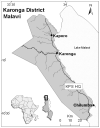What has Karonga taught us? Tuberculosis studied over three decades
- PMID: 19146741
- PMCID: PMC3272402
What has Karonga taught us? Tuberculosis studied over three decades
Abstract
This paper summarises tuberculosis (TB) research over almost 30 years in Karonga District, northern Malawi, an area typical of much of rural Africa. The dominant factor has been the human immunodeficiency virus (HIV), which arrived in the district about 1980, leading to an increase in TB incidence to a peak of approximately 65 smear-positive pulmonary cases per 100000 population in 2000. Tuberculin surveys indicate annual risks of Mycobacterium tuberculosis infection of approximately 1%; thus, most of the population is uninfected and at risk of primary infection and disease. Molecular epidemiological studies demonstrate that about two thirds of TB arises from recent infection, but recognisable recent contact is responsible for only about 10% of disease. By 2001, 57% of TB was directly attributable to HIV, implying that it would have declined were it not for HIV. HIV infection increases the risk of TB most among young adults, and greatly increases the risk of recurrence from new infection after treatment. Mortality rates in the HIV-infected are high, but there is no association of HIV with drug resistance. Other risk factors with relatively smaller effects include age and sex, contact, several genetic polymorphisms and area. Neither one nor two doses of the bacille Calmette-Guérin (BCG) vaccine provides protection against adult pulmonary TB, despite protecting against leprosy. Skin test surveys, cohort studies and comparative immunological studies with the UK suggest that exposure to environmental mycobacteria provides some protection against TB and that BCG's failure is attributable partly to this widespread heterologous exposure masking effects of the vaccine. Drug resistance has remained constant (<10%) over more than 20 years. Immunotherapy with M. vaccae provided no benefits, but treatment of HIV-positive patients with cotrimoxazole reduced mortality. The Karonga programme illustrates the value of long-term population-based studies to investigate the natural history of TB and to influence TB control policy. Current studies focus on immunological markers of infection, disease and protection, and on elucidating the impact of antiretroviral treatment on TB incidence at population level.
Figures







References
-
- Ponnighaus JM, Fine PE, Bliss L, et al. The Karonga Prevention Trial: a leprosy and tuberculosis vaccine trial in northern Malawi. I. Methods of the vaccination phase. Lepr Rev. 1993;64(4):338–56. - PubMed
-
- Ponnighaus JM, Fine PE, Maine N, Bliss L, Kalambo M, Ponnighaus I. The Lepra Evaluation Project (LEP), an epidemiological study of leprosy in northern Malawi. II: Prevalence rates. Lepr Rev. 1988;59(2):97–112. - PubMed
-
- Karonga Prevention Study. 2008. unpublished data.
-
- Glynn JR, Ponnighaus J, Crampin AC, et al. The development of the HIV epidemic in Karonga District, Malawi. Aids. 2001;15(15):2025–9. - PubMed
-
- Crampin AC, Glynn JR, Ngwira BM, et al. Trends and measurement of HIV prevalence in northern Malawi. Aids. 2003;17(12):1817–25. - PubMed
Publication types
MeSH terms
Substances
Grants and funding
LinkOut - more resources
Full Text Sources

